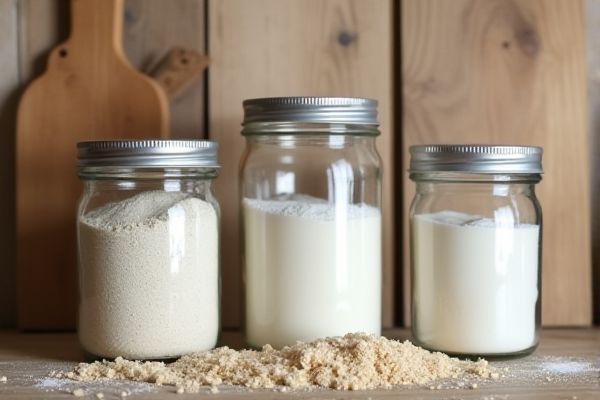
Flour jars typically offer a smaller, more compact storage solution with an airtight seal, ideal for keeping your flour fresh but suited for limited kitchen spaces. Learn more about which option best fits your baking needs and kitchen organization by reading the rest of the article.
Table of Comparison
| Feature | Flour Jars | Flour Canisters |
|---|---|---|
| Material | Glass, Ceramic, Plastic | Metal, Stainless Steel, Ceramic, Plastic |
| Capacity | Small to Medium (1-4 liters) | Medium to Large (2-8 liters) |
| Sealing | Usually airtight lids with silicone or rubber gaskets | Airtight with clamp or locking lids |
| Design | Often decorative and transparent | Functional and stackable |
| Usage | Ideal for daily small-quantity use | Best for bulk storage and longer shelf life |
| Price Range | Generally lower cost | Usually higher cost due to durability and size |
| Portability | Lightweight and easy to handle | Heavier and less portable |
Flour Jars vs Flour Canisters: A Comprehensive Comparison
Flour jars typically offer airtight seals and are often made of glass or ceramic, making them ideal for preserving the freshness and preventing moisture exposure. Flour canisters usually feature larger capacities and are constructed from durable materials like stainless steel or BPA-free plastic, providing better protection against pests and easier stackability in your kitchen. Choosing between flour jars and canisters depends on your storage space, usage frequency, and preference for design, ensuring your flour stays fresh and accessible.
Material Differences: Glass Jars vs Metal or Plastic Canisters
Glass flour jars provide a non-porous, airtight storage solution that preserves flour's freshness by preventing moisture and odor absorption, while metal or plastic canisters offer durability and lightweight convenience but may risk condensation or static cling affecting flour texture. Metal canisters, often made of stainless steel or aluminum, provide robust protection against pests and light but can sometimes impart a metallic odor if not properly lined. Plastic canisters are versatile and affordable but vary in quality; BPA-free options ensure food safety while transparent designs allow easy content monitoring.
Airtight Sealing: Which Option Preserves Flour Best?
Flour canisters generally provide superior airtight sealing compared to flour jars due to their specialized lids with silicone gaskets, which prevent moisture and air exposure more effectively. Airtight flour canisters preserve flour freshness by maintaining optimal humidity levels, reducing the risk of spoilage and insect infestation. While some flour jars with rubber seals offer decent airtightness, canisters are typically preferred for long-term flour storage.
Storage Capacity: Comparing Size and Volume
Flour jars typically offer smaller storage capacity, ranging from 1 to 4 cups, making them ideal for limited kitchen spaces and short-term use. Flour canisters generally provide larger volumes, often between 4 to 12 cups or more, suited for bulk storage and frequent baking needs. Choosing between jars and canisters depends on kitchen size, baking frequency, and the desired amount of flour to store.
Kitchen Organization: Aesthetic and Functional Considerations
Flour jars provide a sleek, transparent design that enhances kitchen aesthetics by showcasing the flour's texture and color, promoting a clean and organized look on open shelves or countertops. Flour canisters, typically opaque with airtight seals, prioritize functionality by protecting flour from moisture and pests, making them ideal for long-term storage and maintaining freshness. Choosing between jars and canisters depends on balancing visual appeal with practical storage needs in kitchen organization.
Ease of Use: Accessibility and Pouring Convenience
Flour jars often feature wide openings and clear markings, making it easy to access and measure your flour accurately. Flour canisters typically come with airtight lids and spouts designed for controlled pouring, reducing spills and mess. Choosing the right container enhances your baking efficiency by improving accessibility and pouring convenience.
Cleaning and Maintenance: Jars vs Canisters
Flour jars typically feature a simple design with wide openings, making them easier to clean thoroughly by hand or in the dishwasher. Flour canisters often have airtight seals and more complex lids, which can trap residue and require more meticulous cleaning to prevent mold or stale flour. Choosing between jars and canisters depends on balancing ease of maintenance with the need for prolonged freshness and moisture control.
Cost Comparison: Affordability and Value
Flour jars typically offer a more affordable option compared to flour canisters, making them ideal for budget-conscious buyers seeking basic storage. Flour canisters often come with airtight seals and durable materials, providing better preservation and long-term value despite their higher initial cost. Your choice depends on whether you prioritize upfront savings or investment in maintaining flour freshness.
Sustainability and Environmental Impact
Flour jars, often made from glass or ceramic, are reusable and recyclable, offering a sustainable alternative by reducing single-use plastic waste. Flour canisters, typically made from durable materials like stainless steel or BPA-free plastic, prioritize long-term use and airtight storage, minimizing food spoilage and waste. Choosing eco-friendly materials and ensuring product longevity in both options significantly lowers environmental impact and promotes sustainable kitchen practices.
Best Choice for Your Kitchen: Final Recommendations
Flour canisters offer airtight seals and larger capacities, making them ideal for maintaining flour freshness and minimizing moisture exposure in busy kitchens. Flour jars, often more compact and decorative, suit smaller spaces or casual baking needs but may lack the airtight protection needed for long-term storage. For optimal kitchen organization and flour preservation, choosing a flour canister is the best recommendation.
 homyna.com
homyna.com